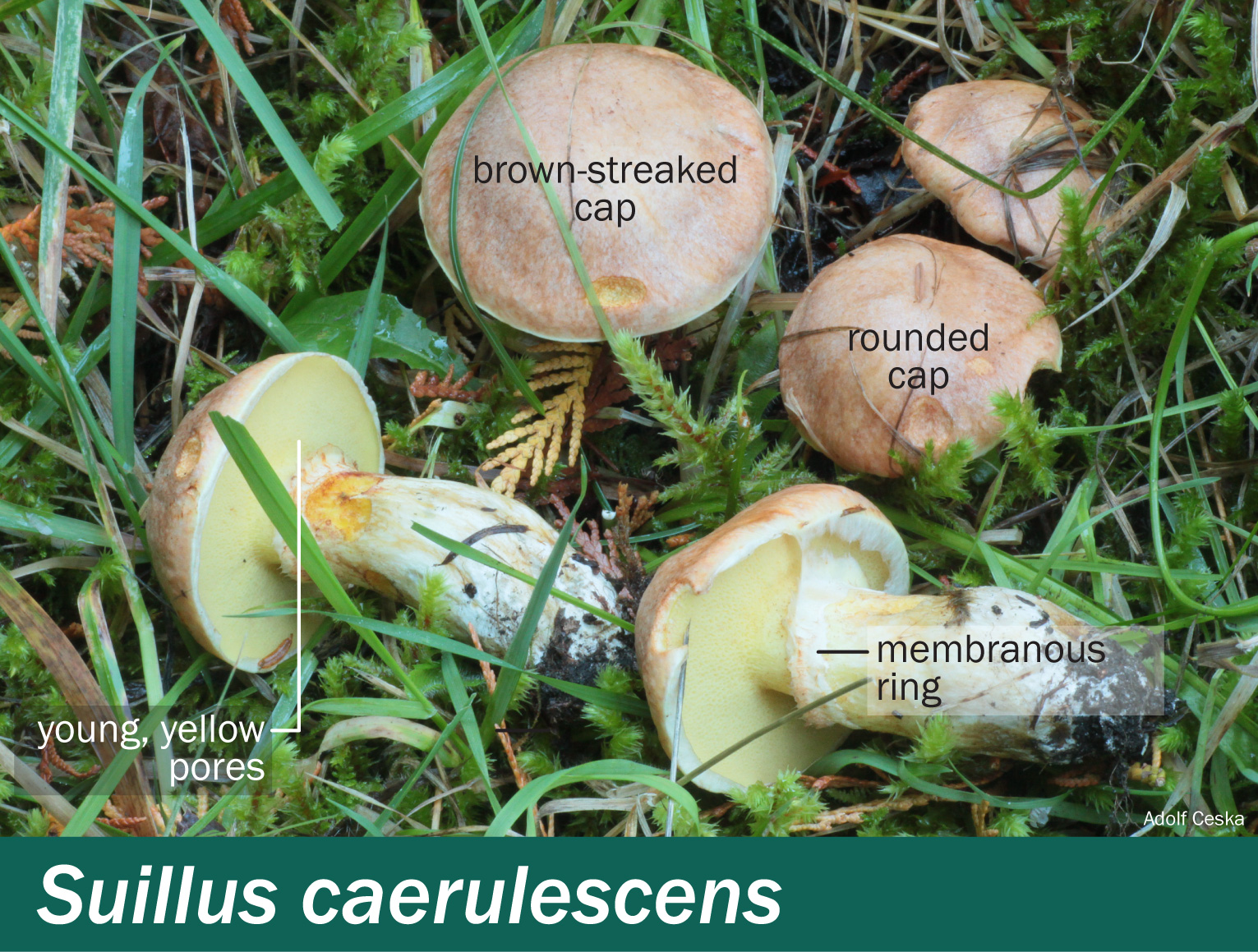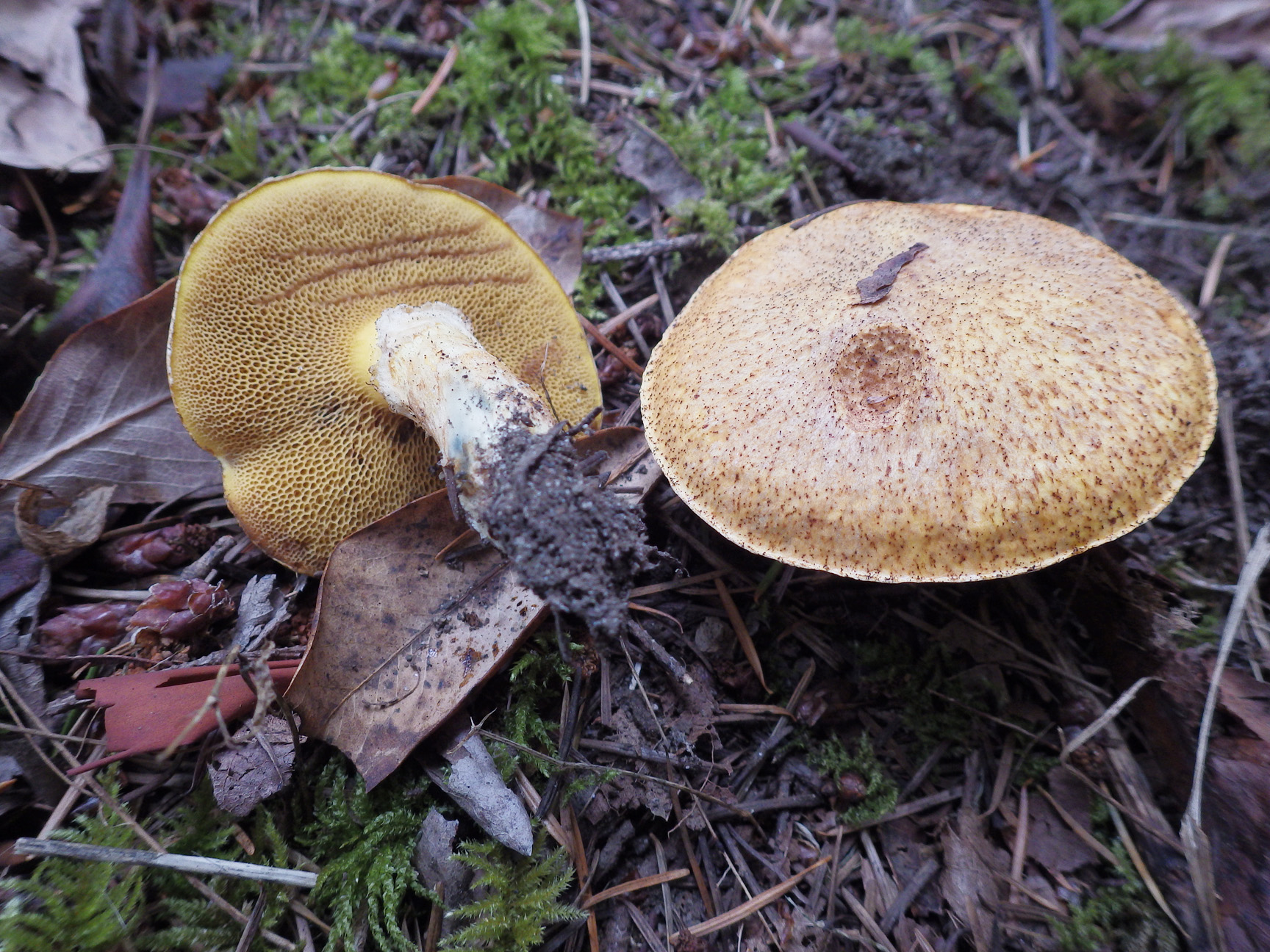Suillus caerulescens — Fat jack, Douglas fir slippery jack
Odour: Mild.
Taste: Mild, lemony.
Cap: 5–14 cm in diameter. Caps hemispherical when young, expanding and becoming flatter with age. The colour is yellowish tan to light brown with brownish fibrils or small scales. Surface may be dry or wet/slimy if weather is moist. The flesh is thick. Caps look like troops of bakery buns around Douglas fir trees.
Pores: On the underside of the cap are angular pores ~1-2 mm wide. Pore surface is light yellow when young, darkening to ochraceous with age. Pore colour changes to brown after being rubbed (check ~10 min after rubbing, see image above).
Stem: 2.5–8 cm long x 1–3 cm wide often tapering at the base. Colour is bright yellow above the ring and whitish with brownish stains below. Flesh in cap and stem is initially whitish, becoming yellow with age. The base of the stem will often turn blue if rubbed (check ~10 min after rubbing, see 'Additional image').
Ring or veil: The membranous or felty partial veil initially covers the pore surface. As the cap expands, part of the veil remains on the stem forming a ring, and ragged pieces of the veil may dangle from the margin of the cap. The ring is whitish, with cinnamon brown stains.
Cup: None.
Spores: 7–11 x 4–4.5 µm, cinnamon brown, smooth.
Habitat: Single or in small groups on the ground near Douglas fir (Pseudotsuga menziesii) host trees. Ectomycorrhizal.
Geographic distribution: This species depends on Douglas fir trees and is common in western North America where its partner trees are found.
Taste: Mild, lemony.
Cap: 5–14 cm in diameter. Caps hemispherical when young, expanding and becoming flatter with age. The colour is yellowish tan to light brown with brownish fibrils or small scales. Surface may be dry or wet/slimy if weather is moist. The flesh is thick. Caps look like troops of bakery buns around Douglas fir trees.
Pores: On the underside of the cap are angular pores ~1-2 mm wide. Pore surface is light yellow when young, darkening to ochraceous with age. Pore colour changes to brown after being rubbed (check ~10 min after rubbing, see image above).
Stem: 2.5–8 cm long x 1–3 cm wide often tapering at the base. Colour is bright yellow above the ring and whitish with brownish stains below. Flesh in cap and stem is initially whitish, becoming yellow with age. The base of the stem will often turn blue if rubbed (check ~10 min after rubbing, see 'Additional image').
Ring or veil: The membranous or felty partial veil initially covers the pore surface. As the cap expands, part of the veil remains on the stem forming a ring, and ragged pieces of the veil may dangle from the margin of the cap. The ring is whitish, with cinnamon brown stains.
Cup: None.
Spores: 7–11 x 4–4.5 µm, cinnamon brown, smooth.
Habitat: Single or in small groups on the ground near Douglas fir (Pseudotsuga menziesii) host trees. Ectomycorrhizal.
Geographic distribution: This species depends on Douglas fir trees and is common in western North America where its partner trees are found.
Rule out poisonous species before eating a mushroom with a 'bakery bun' shape. First look closely at the underside of the cap; in fat jacks, this surface is always covered with pores. Poisonous Cortinarius species with a similar shape have gills not pores. Check that the pores and the top of the stem are yellow and that a ring is present. Poisonous species including Rubroboletus eastwoodiae and Neoboletus erythropus have pores that usually change to blue/black within ~10 min of being rubbed; their pores are orange or red, not yellow; and they lack veils and rings. If the flesh of the mushroom tastes bitter, the species is not a fat jack and it is likely poisonous.
Several similar-looking Suillus species fruit abundantly in fall. Like the fat jack, the western painted slippery jack (Suillus lakei) and Suillus ponderosus are ectomycorrhizal partners with Douglas fir. The western painted slippery jack has a darker red-brown, scalier cap than the fat jack. Suillus ponderosus closely resembles the fat jack, but its ring becomes wet-looking and gelatinous while the ring of the fat jack remains membranous. When old and wet, slippery jack species lose their distinctive characters and they all look alike.
Fat jacks and other species of slippery jack are edible for most people. Some people experience allergic skin irritation after touching mushrooms of slippery jack species6,7. A few individuals have experienced gastrointestinal upsets after eating species of slippery jacks6.
Treatment: Contact your regional Poison Control Centre if you or someone you know is ill after eating pored mushrooms. Poison Centres provide free, expert medical advice 24 hours a day, seven days a week. If possible, save the mushrooms or some of the leftover food containing the mushrooms to help confirm identification.
Poison Control:
British Columbia: 604-682-5050 or 1-800-567-8911.
United States (WA, OR, ID): 1-800-222-1222.
1
MyCoPortal. Mycology Collections Portal, <http://mycoportal.org/portal/collections/harvestparams.php>, accessed March 2018.
2
Specimen Suillus caerulescens UBC F26124 MO 147967, GenBank #MH718199.
3
Arora, D. Mushrooms Demystified. Ten Speed Press, Berkeley, California (1986).
4
Nguyen, N. H., Kerekes, J. F., Vellinga, E. C. & Bruns, T. D. Synonymy of Suillus imitatus, the imitator of two species within the S. caerulescens/ponderosus complex. Mycotaxon 122, 389-398 (2012).
5
Siegel, N. & Schwarz, C. Mushrooms of the Redwood Coast. A Comprehensive Guide to the Fungi of Coastal Northern California. Ten Speed Press, Berkeley, California (2016).
6
Beug, M. W., Shaw, M. & Cochran, K. W. Thirty-plus years of mushroom poisoning: Summary of the approximately 2,000 reports in the NAMA case registry. McIlvainea 16, 47-68 (2006).
7
Bruhn, J. & Soderberg, M. Allergic contact dermatitis caused by mushrooms. Mycopathologia 115, 191-195, doi:https://doi.org/10.1007/BF00462225 (1991).
8
Specimen Suillus caerulescens UBC F26078 MO 146031, GenBank #MH718198.


